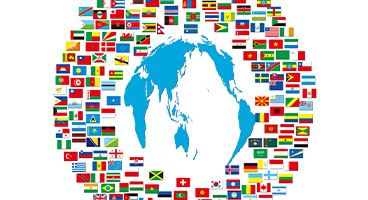
- Table of Contents
1. What Is Trados?
Translation work requires time and effort, but it can be significantly streamlined by utilizing the latest technology. In particular, Computer-Assisted Translation tools (CAT tools) and Translation Management Systems (TMS) are highly-sought software for translation departments and translators. In this blog, we will introduce two globally-utilized software solutions: the CAT tool, Trados Studio, and the translation management system, Trados GroupShare.
Trados Studio is a computer-assisted translation tool originally developed by the German company Trados. As a result of mergers and acquisitions, it is now owned and distributed by the UK-based RWS Group. Translators and companies around the world love this software, thanks to its rich features and stability. It has established itself as what many consider the de facto standard in the translation industry.
When used in conjunction with Trados Studio, Trados GroupShare streamlines the management of translation projects. As a translation management system, GroupShare enables centralized sharing of translation memories and glossaries within the team, in addition to project management and progress monitoring.
2. Translation Tool Types: CAT Tools Vs. Translation Management Systems
Computer-assisted translation tools provide features such as translation memories and glossaries (term bases) to improve the efficiency and quality of translation work for translators. These tools are mainly used by translators and reviewers. For more details, you can check out the blog post below.
"What Are CAT Tools? Introducing the Benefits and Drawbacks"
A translation management system is a system that enables translation project managers to efficiently manage translation projects. Managers can track the progress of translation projects and orchestrate the management and sharing of translation memories, term bases, and the projects themselves, all in one place. Trados GroupShare is a translation management system that operates in the cloud and is used to efficiently manage translation projects. For more details, be sure to read the blog post below.
"What Is a Translation Management System?"
Trados Studio supports the utilization of machine translation software. Machine translation, also referred to as "MT," uses technologies such as machine learning and natural language processing to perform translations in the place of a human translator. In recent years, neural networks modeled after the human brain have been trained on large swathes of translated materials (source texts and their translations) to achieve more natural translation results than ever before automated. However, machine translation cannot guarantee perfect translations, and human verification is essential. Notable machine translation services include DeepL and Google Translate. For more details, we recommend the blog post linked below.
"Latest Trends in Machine Translation and a Comparison of 'DeepL' and 'Google Translate'"
Our company offers a product called MTrans for Trados, which facilitates the use of automatic translation tools like DeepL and Google in Trados Studio. It lets you utilize multiple automatic translation engines and improve the accuracy of your automatic translations with glossaries and style replacement features. To learn more, please visit the product page below.
3. The Capabilities and Features of Trados
1. Translation Memory Function and Machine Translation Function
Trados is equipped with translation memory and machine translation functions. Translation memories store paired language units of source passages with their respective translations from previously translated texts, allowing you to utilize existing translations whenever the new text resembles what's stored in the memory. In particular, Trados includes a technology feature called upLIFT, which improves the accuracy of the adopted translations when the original text matches the previous source text in part, but not entirely. Furthermore, Trados also includes a machine translation function. By utilizing both the translation memory and machine translation functions, the need to translate sentences from scratch is reduced, thereby improving translation efficiency.
2. Support for over 50 File Formats
Trados supports over 50 file formats, including common formats such as Word, Excel, PowerPoint, and PDF, as well as specialized formats like HTML and XML. Not to mention, even if a file format is proprietary to a company, it can still be translated in Trados by creating a file conversion filter.
3. Centralized Data Management
With Trados GroupShare, all project data is centralized, allowing project managers and translators to quickly and easily access project information. Not only can the progress of the project be monitored in real-time, but translation memories and terminology databases can also be shared between parties. This ensures consistent translations based on the most up-to-date information, even amongst multiple translators, making it especially useful for large-scale projects.
4. The Benefits of Implementing Trados
1. Maintaining and Improving Translation Quality
By utilizing translation memory, glossaries, and QA functions, you can sustain and improve translation quality over time. First, the translation memory helps you maintain consistent quality in your translations and boosts accuracy. Then, applying a glossary, which is a centralized database of specialized terms and proper nouns related to specific industries or projects, ensures consistent terminology during translation, also improving the translation quality. Furthermore, Trados' QA function enables you to check the translation for certain mistakes, such as grammar and spelling errors, inconsistently translated terms, and missing tags. By correcting these issues, translators can enhance translation quality. By leveraging all these features, translation projects using Trados can achieve better and more consistent translation quality.
2. Accelerating Delivery
By maintaining and managing translation memory, the need to translate from scratch is reduced, significantly accelerating delivery times. Translation memory is useful not only during revisions of the same document but also when translating other similar documents. In many cases, similar sentences can be reused from past translations. Even when only a portion of the original text matches documents in the memory, translating only the parts that have changed based on the existing translation improves the efficiency of the translation work. Depending on the amount of reusable text, a translation memory can reduce the man-hours required for translation by 10% to 70%. Additionally, using GroupShare makes it easier for multiple translators and reviewers to work simultaneously. So for big projects in particular, multiple files can be worked on in parallel, shortening the delivery time.
3. Reducing Costs
By utilizing translation memory, translators can reuse past translation data, which reduces the actual amount of translation required, shortens the time needed for translation work, and ultimately leads to lower costs. The positive impact of translation memory is significant, and it is worth implementing translation support tools for this feature alone.
4. Security Measures
Trados puts a strong emphasis on protecting translation data. When working in Trados Studio, your data is stored locally, which reduces the risk of data leaks. And even when using GroupShare, communications are encrypted, so translation data can be exchanged safely.
Thanks to such features, Trados products are highly valued in the translation industry and are used by many translators and companies. Leveraging these features improves the quality, efficiency, cost, and security of translation projects, thereby optimizing the entire translation process.
For a case study on the implementation of Trados and MTrans for Trados by one of our clients, please follow the link below.
5. Summary
Trados is software that provides computer-assisted translation tools (CAT tools) and a translation management system (TMS), helping to improve the efficiency and quality of translation work. Trados Studio benefits translation tasks by enabling the application of translation memories and glossaries, while Trados GroupShare centralizes the management of translation projects and facilitates data sharing within teams. Additionally, Trados can integrate with machine translation software through MTrans for Trados, a tool provided by Human Science, which allows the use of automatic translation from services like DeepL and Google. By implementing Trados, you can improve translation quality, shorten delivery times, reduce costs, and enhance security measures, enabling the overall optimization of translation tasks. A free trial is available, so please feel free to contact us.
Related Services
MTrans for Trados

























